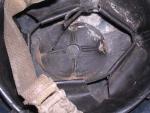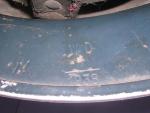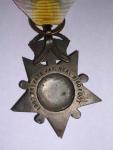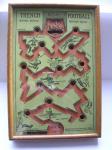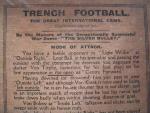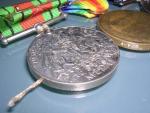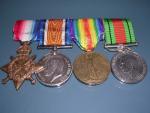-
Posts
3,687 -
Joined
-
Last visited
-
Days Won
2
Content Type
Profiles
Forums
Blogs
Gallery
Events
Store
Everything posted by Tony
-
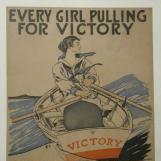
Acting Conductor on medal rim
Tony replied to Tony's topic in Great Britain: Orders, Gallantry, Campaign Medals
Thanks for the replies. Still no luck finding his MIC but I'll keep searching. Tony -
Hello, Can anyone tell me what an Acting Conductor in the Supply and Transport Companies may have done during the Great War? Would he have been in the ASC, AOC, worked on busses or had something to do with music? What's the rank of Acting Conductor equivalent too? I've bought a medal to a soldier of that rank but can't find his MIC although I did find his MSM award card which doesn't show his service number. Thanks Tony
-

British 5th Division badge,WW1?
Tony replied to elephant12's topic in Great Britain: Militaria: Badges, Uniforms & Equipment
-

SOUVENIRS FROM FRANCE
Tony replied to Mervyn Mitton's topic in Great Britain: Militaria: Badges, Uniforms & Equipment
Nice cards Brian. I've been searching for the post of my one which was sent to Germany but can't find it. I'd do another scan now if it wasn't packed away in storage miles and miles away. Tony -

SOUVENIRS FROM FRANCE
Tony replied to Mervyn Mitton's topic in Great Britain: Militaria: Badges, Uniforms & Equipment
Mervyn, I have a few of these, one of them is similar to the one pictured above with a card inside the flap, the card has a handwritten message in German. I can only imagine it was picked up by a German soldier on the advance and then posted home. It's on the forum somewhere but a search came up empty. I posted the scan quite a while back so maybe it's just not here now. Leigh's memory is quite good, he may be able to describe it in more detail than I can as I remember him commenting on it. Tony -
These could possibly be one of the maker marks on the liner or shell of Canadian made helmets, if you can find the faint outlines on the liner: C.L./C. - Canadian Lamp Co., G.S.W. - General Steel Wares and Aluminium Goods A.G./.C. - Aluminium Goods Company (apparently they made helmets for the RCAF) Below is a photo of a policeman's helmet, the liner has the Everett W Vero & Co. stamp from London, the shell has the WD - William Dobson & Son from Birmingham stamp. Something I've noticed is that most Civil Defence helmets appear to have an oval padding riveted to the liner as opposed to the standard cross padding as shown in the Canadian helmet above. I think I've also seen oval padding in SA helmets too. Has anyone seen Canadian helmets with the oval padding? Tony
-

Unit ID please
Tony replied to Tony's topic in Great Britain: Militaria: Badges, Uniforms & Equipment
Never noticed that Mervyn, Would have been nice of him to pose with the bike, but we can't have everything. Tony -

Kabul to Kandahar Star
Tony replied to Tony's topic in Great Britain: Orders, Gallantry, Campaign Medals
That's a definite possibility Darrell. Your star has a very nice dark patina, the ribbon, just as mine, has that new look about it. Tony -

Bronze BWM collection
Tony replied to Brian Wolfe's topic in Great Britain: Orders, Gallantry, Campaign Medals
Brian, I've been looking for a nice bronze BWM for some time and although they're not that rare, whenever one I really like turns up I don't have the spare cash. One day I will buy one, the last one I fancied was to a Macedonian translator I think. Maybe I'm mixing it up with something else but it was Macedonian. Owain, your BWM is something that would definitely take my fancy. Tony -

Kabul to Kandahar Star
Tony replied to Tony's topic in Great Britain: Orders, Gallantry, Campaign Medals
Thank you and you're most welcome Brian. Would you know if these are found with original ribbons? This one and all the others I've seen (I haven't really seen too many) have been on modern clean ribbons although they do appear to be silk as opposed to nylon. Tony -

Unit ID please
Tony replied to Tony's topic in Great Britain: Militaria: Badges, Uniforms & Equipment
Thanks everyone. I think that's the first time I've ever had an idea of what the cap badge could be. Would he have been a dispatch rider as Mervyn suggested and I know carrying a SMLE on a bike would be a pain so is that the reason for the revolver? Tony -

Kabul to Kandahar Star
Tony replied to Tony's topic in Great Britain: Orders, Gallantry, Campaign Medals
Lord Roberts order from 8th August 1880, Sherpur, Kabul It has been decided by the Government of India that a force shall proceed with all possible despatch from Cabul towards Khelat-i-Ghilzai and Candahar for the relief of the British garrison in those places, now threatened by a large Afghan army under the leadership of Sirdar Mahomed Ayub Khan. By mid 1880 the British army was ready to leave Afghanistan and return to Peshawar in what is now Pakistan with the cooperation of the new Afghan commander Aburrahman, but towards the end of July 1880 Ayub Khan (a nephew of Aburrahman Khan) fought and beat units of the British army in Maiwand causing around 1146 casualties, 969 of them being killed. Those still alive retreated to the British garrison in Kandahar. The plan was for Lord Roberts to march with chosen regiments to Kandahar, British regiments being in the minority. General Phayre who was nearer to Kandahar was to march from Quetta and General Donald Stewart would take the remainder back to India. It was necessary to reach Kandahar with speed, therefore Lord Roberts decided to move lightly and ordered the men take very little kit, no wagons and only light mountain batteries. These batteries may have been either the 1865 7 Pounder rifle muzzle loading guns or the ultra modern 2.5'' 1879 gun with a barrel that split in two making transport easier. But, knowing the British army, the 1879 guns were probably issued for field use until the Boer War. The 10,000 strong army headed out of Sherpur, the 60/2 Foot had a contingent of 637 soldiers. The men didn't march along the direct route to Kandahar, instead they used a route whereby supplies could be gathered along the way although this meant some very hard climbs along narrow roads had to be made. The march carried on without any problems from Afghans. The conditions, marching early morning in darkness and cold, tempertures reaching around 40°C during the day, sand storms and sickness took there toll. Some soldiers commited suicide. The army was at times marching twice as far as they would during a war. By the time Kandahar was reached, General Phayre's march had had several problems on the way, being attacked several times and the troops suffering much sickness, he was still a few days away from Kandahar. On 31st September when Lord Roberts arrived in Kandahar, he himself was also quite sick with fever being carried in on a dhoolie or bed carried by natives. His fever didn't stop him finilising plans to attack the Afghan army the next day. The British attack at Kandahar on 1st August 1880 was successful, afterwards they moved on to bury the dead at Maiwand. The troops who took part in the march were back in India within a few months and Lord Roberts went to England to recover from his illness. Partiall timeline for the 2nd Anglo/Afghan War 14.12.1879 Attack on Asmai Heights and retreat into Sherpur 15-22.12.1879 Seige of Sherpur 23.12.1879 Lord Roberts defeats Afghans at Sherpur 1880 1.4.1880 General Donald Stewart leaves Kandahar for Kabul 19.4.1880 Battle at Ahmed Khel 23.4.1880 Battle at Arzu 26.4.1880 Battle at Charasiab 2.5.1880 General D Stewart reaches Kabul 15.6.1880 Ayub Khan leaves Herat for Kandahar 14.7.1880 mutiny among Wali Mohammad's troops 22.7.1880 Abdurrahman recognised as Amir 27.7.1880 Battle at Maiwand 6.8.1880 Ayub Khan besieges Kandahar 8.8.1880 Lord Roberts leaves Kabul to march to Kandahar 11.8.1880 Stewart leaves Kabul for India 16.8.1880 Sortie on Deh Khoja 31.8.1880 Roberts reaches Kandahar 1.9.1880 Battle of Kandahar 1881 22.4.1881 British evacuate Kandahar In November of 1878 part of the 60/2 Foot was put on escort duty to the Artillery. They reached Kandahar on January 8th 1879, one day after the surrender. From here they went to Kelat i Ghilzni, returning to Kandahar towards the end of March 1880. April 19th 1880 saw the 60/2 Foot take part in the battle of Ahmed Khel before leaving for Kabul in July. After the battle of Kandahar in August 1880 they returned to India, fighting the Marri tribes and returning to Mirat on 24th November 1880. Much of the above information was found on this interesting website http://www.garenewing.co.uk/angloafghanwar/index.php Tony -
The Kabul to Kandahar Star was awarded to the men who took part in Lord Roberts march to Kandahar to relieve the remnants of the British soldiers who retreated from Maiwand on 27th July 1880. This Star, awarded to Pte. James Neal of the 2nd battlion, 60th Foot Regiment KRRC is part of a broken group, I'm hoping the other medal will turn up one day. The 10,000 or so Stars issued were produced using the bronze from some of Ayub Khan's guns captured at Kandahar. I've read that Lord Robert's horse was awarded the Kabul to Kandahar Star too. All I can make out from Pte. Neal's papers are that he came from London, volunteered at the age of 18 arriving at his recruit unit on 19th Aug. 1870 and left for India in November 1870, landing on 28th December where he proceeded to his unit in Peshawar. During April, May and June 1873 he was in Changlas Gully. For the same period in 1875 he was in Kalabagh. I think both are now in Pakistan. He was discharged in London on 14.8.1882, cause of discharge was 1st Period. If anyone can explain the meaning of 1st period please let me know. The other part of this broken group is the Afghan War Medal with clasps Ahmed Khel and Kandahar. I can't narrow him down on the census records, there are several of that name in London and of the correct age. One of them may even be a distant relative of mine. Tony
-

Unit ID please
Tony replied to Tony's topic in Great Britain: Militaria: Badges, Uniforms & Equipment
Hopefully the details will be better in this scan but they're only as clear and sharp as the photo. Tony -
Can anyone ID this soldier's unit? He's wearing something like driving goggles, has an bi-coloured armband on each arm under his stripes and a cap badge that just isn't very clear. I'm not sure if the writing at the bottom of the card will help, it could be his name or nickname for all I know, looks like Capper/Crapper/Copper to me but don't think he's a MP as the it looks more like the RE badge to me. Any ideas? Thanks Tony
-

An old trench game
Tony replied to Tony's topic in Great Britain: Militaria: Badges, Uniforms & Equipment
No Mervyn, I would think it was probably a child's game. for children around 10-12 years old maybe and only in families that could afford such games/toys. Tony -

Why erase the name on a Defence Medal?
Tony replied to Tony's topic in Great Britain: Orders, Gallantry, Campaign Medals
So, someone paid to have it done, sold it, lost it or pawned it and was probably later bought by Mr. Liddell who lost his own or thought he deserved one. Which is what I originally thought may have happened. Chris is probably correct in saying not so many examples were available years ago so, maybe Mr. L took the first one he could find. Tony -
After seeing the link to an online trench warfare game posted by Claudius, I thought I'd post a photo of my 'manual' trench warfare game although the official name is trench football. You may be able to see the silver ball in the photo which has some rust and therefore doesn't always go in the intended direction. It can sometimes give me no end of fun. Does anyone have anything similar? Tony
-

Why erase the name on a Defence Medal?
Tony replied to Tony's topic in Great Britain: Orders, Gallantry, Campaign Medals
Brian, I'm not sure if Australia did issue the medal in silver but I have seen one in an Australian group. I honestly think this soldier added the medal himself, he has a Scottish name or at least after trawling through the records on ancestry it would appear to be Scottish. Canada has quite a few people who originated from Scotland plus the silver medal leads me to believe he possibly moved to Canada between the wars or after WWII. I've been told that the group has been in the collection of a former RAAF pilot so it's possible he collected groups to airman in particular, the trio being RFA on the Star and RAF on the pair. Who knows, maybe he moved to Australia and was somehow involved in the raid on Darwin. It's something we'll never know as I can't find any records on ancestry or the AWM site. But, my money's on him moving to Canada and believing he should have received the Defence Medal or had lost his own. Tony -
Thanks Heiko. I only have one clasp which I bought years ago in Germany but unfortunately I don't know where it is at the moment and don't have a photo of it either. It's the Brest-Litovsk clasp. Are some rarer than others? Although I have many Imperial German bits and bobs my main collecting area is WWI Commonwealth, hence the cluelessness here. Tony
-

Strange group...
Tony replied to Chris Boonzaier's topic in Great Britain: Orders, Gallantry, Campaign Medals
Don't know if this helps Chris but here are the issue entitlements. Defence Medal: Service in the Forces in non-operational areas subjected to air attack or closely threatened, providing such service lasted at least three years. Non-operational service in the Forces overseas or outside the country of residence, providing that this service lasted for at least one year. If the territory was threatened by the enemy, or subjected to air raids, the duration requirement was reduced to six months. Civil defence in military operational areas providing these civil defence activities were not eligible for campaign stars. Members of any of the civilian services entitled to wear chevrons for their war service were eligible for this medal. Members of the Home Guard resident in the UK, who had completed at least three years service. Recipients of the George Cross or George Medal, regardless of their occupation, provided the George Cross or George Medal were won for service in civil defence. War Medal: Awarded to all full time personnel of the Armed Forces. Operational and non operational service of at least 28 days. The Merchant Navy requirement stated that the 28 days minimum should be served at sea. The recipient was awarded this medal if their service period was terminated by their death, disability due to service or capture as a prisoner-of-war and their service qualified them for one of the stars. Also if the recipient had received one of the stars for a service period of less than 28 days, they were also awarded the War Medal. The UK War Medals were made from cupro-nickel, whilst the Canadian War Medal is made from silver. Those War Medals issued to UK personnel were not officially named. However, those issued to Australian and South African personnel were officially named. 39-45 Star: This star was awarded for service in the Second World War between 3 September 1939 and 2 September 1945. The recipient was awarded this star if their service period was terminated by their death or disability due to service. Also the award of a gallantry medal or MID also produced the award of this medal, regardless of their service duration. Royal Navy personnel had to complete 6 months service afloat in active operational areas. Army personnel had to complete 6 months service in an operational command. Airborne troops qualified if they had participated in any airborne operations and had completed 2 months service in a fully operational unit. RAF personnel had to participate in operations against the enemy providing that 2 months service had been completed in an operational unit. Non-aircrew personnel had to complete 6 months service in an area of operational army command. Merchant Navy qualified if they completed 6 months service, and at least 1 voyage was made through an operational area. Members of fighter aircraft crews who took part in the Battle of Britain (10 July to 31 October 1940) were awarded the "Battle of Britain" bar to this medal. Africa Service Medal: To qualify for the medal, a member of those services must have volunteered for war service outside South Africa, and have served continuously for thirty days, or part-time for a total of eighteen hours, between 6 September 1939 and 2 September 1945. As the name indicates, the medal was originally intended for service in Africa, up to the defeat of the Axis forces in North Africa 1943, but it was later extended to cover service anywhere in the world, right up to the end of the war. My only SA group includes the 39-45 Star, Africa Star, War Medal and Africa Service Medal but no Defence Medal. Tony -

Why erase the name on a Defence Medal?
Tony replied to Tony's topic in Great Britain: Orders, Gallantry, Campaign Medals
Thanks for the replies and thoughts. I have seen named SA Defence Medals, Canadian and I've also seen Australian Defence Medals in silver. I personally believe either the man in question moved overseas (Canada, SA, Australia, India, who knows) and acquired the extra medal because he lost his own one or felt he deserved it as he may have served in the forces in non-operational area subjected to air attack or closely threatened for only 2 years 11 months instead of the three years necessary. It's also possible it has just been added to the group but one thing in my mind is certain, the ribbons although all original do not look like they've been mounted/worn by a proud veteran of 2 world wars, they're too clean. Mounted by a family member after his death, a collector or a dealer? We'll never know. By the way the letter Y is still visible on the rim. Tony -

Why erase the name on a Defence Medal?
Tony replied to Tony's topic in Great Britain: Orders, Gallantry, Campaign Medals
-
Hello all, I bought this medal group recently and after collecting them from the post office I noticed the Defence Medal is the solid silver type and also that at some point over the last 60 years it has had the name of the original recipient erased. I know some old soldiers who have maybe lost a medal or pawned it may buy another and remove the naming, other than that I don't see the point of erasing a Defence Medal, it's not as if there's any financial gain for the crims out there. What puzzles me is why a silver medal has been erased instead of using a standard unnamed cupro nickel medal or even an unnamed silver one. It's a Brit group which was bought in Australia. Did Australia issue silver Defence medals or could this be a group that originally went from England to Canada, then Australia? The original recipient could even have moved overseas after WWII and thought he was due the medal, not wanting all the hassle of applying maybe he just bought one and filed the name off. Any thoughts? Tony



